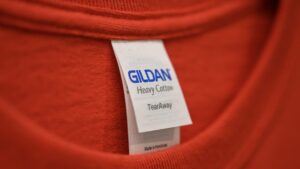Why Gildan Activewear is a Hidden Gem in Today’s Market: Analyzing Tariffs and Strategic Opportunities
As the investment landscape becomes increasingly influenced by geopolitical factors, savvy investors are looking for opportunities that can stand out amidst the noise. One company that has recently caught the spotlight is Gildan Activewear, and it’s worth delving into why this apparel manufacturer may be a compelling option for your investment portfolio—especially if tariffs on Chinese goods remain in place.
Tariffs and Market Dynamics: An Overview
Recent analysis from UBS points to an optimistic outlook for Gildan Activewear, suggesting that President Donald Trump’s potential 55% tariff on Chinese imports could actually play to the company’s advantage. Analyst Jay Sole remarked, “Our view is tariffs are a negative for almost all softline companies, but Gildan stands apart.” This unique positioning allows Gildan to seize market share while many competitors grapple with increased production costs.
A Strategic Sourcing Model
At the heart of Gildan’s resilience is its strategic sourcing model. The company has leveraged its manufacturing capabilities in South America, which allows it to face a significantly lower tariff of under 10% when exporting goods to the U.S. This competitive edge not only minimizes costs but also draws potential partnerships with companies looking for alternatives to Chinese manufacturing amid rising tariffs.
Furthermore, Gildan’s vertically integrated manufacturing process enables it to produce high-quality items like t-shirts and fleece in-house, primarily from Central American facilities. This means more control over quality and costs—an essential factor that many investors overlook.
Strong Buy Rating with Significant Upside Potential
UBS has reiterated a buy rating for Gildan with a target price of $56 per share, suggesting an impressive upside of approximately 14% from the recent closing price of $47.86. Even more intriguingly, UBS posits that Gildan could potentially see returns exceeding 80% as it capitalizes on the shifting dynamics in the apparel market.
While Gildan shares experienced a slight pullback of about 4% this year due to ongoing trade talks, analysts believe that market sentiment doesn’t fully account for the company’s potential share gains. “We have high conviction in this view based on conversations with investors,” Sole emphasized. This could indicate that now might be the optimal time to consider a position in Gildan before these advantages are reflected in the stock price.
Industry Sentiment: Echoing Confidence
Citi analyst Paul Lejuez has voiced similar sentiments, highlighting Gildan’s unique production capabilities in South America as a significant factor favoring the stock. As more softline companies reconsider their supplier relationships in light of tariffs, Gildan stands poised to benefit as a trusted partner.
Conclusion: A Strategic Play for Informed Investors
As an investor, understanding the broader implications of tariffs and their impacts on different sectors is essential. Gildan Activewear represents an appealing opportunity, especially in a volatile market where many softline manufacturers are adversely affected.
At Extreme Investor Network, we encourage you to further explore the implications of these market dynamics. With Gildan Activewear, you’re not just investing in a clothing manufacturer; you’re positioning yourself to take advantage of a strategic shift in the industry landscape. In a world where uncertainty is rampant, Gildan could very well be the beacon of opportunity you’ve been searching for.
Stay tuned for more insights and unique perspectives on investment opportunities that matter.

